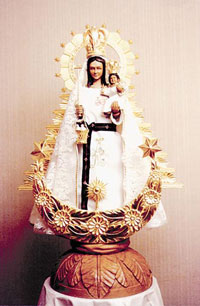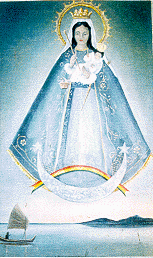Our Lady of Copacabana

Patroness of Bolivia, Bolivian navy
Feast: August 5; formerly February 2
Where it is part of Bolivia, the peninsula of Copacabana penetrates Lake Titicaca near the islands of the Sun and Moon, sacred sites of the Incas. It is here, at 4800 meters above sea level, that devotion to the "Most Blessed Virgin de la Candelaria, Our Lady of Copacabana", originated. This statue of the Virgin Mary stands four feet tall, is made of plaster and fiber from the maguey tree, is completely covered with gold leaf, except for the face and hands; the garments reproduce the colors and dress of an Inca princess. Her soft expression - and that of the Child she holds as if it were about to fall - recall the features of the inhabitants of the region. The statue is the work of Francisco Tito Yupanqui, a descendant of the Inca Huayna Capac. The original shape is permanently hidden by rich robes and cloaks, and the carved hair has been covered by a wig. The image never leaves the basilica; a copy is used for processions.
The first efforts of this inexperienced sculptor were rejected, but finally his love and perseverance produced this image of the Virgin which was humbly enthroned in a poor adobe church on February 21 1583, making it one of the oldest Marian sanctuaries in the Americas. Over the centuries the image was showered with valuable jewels and the church with treasures which were later looted by presidents, dictators and generals. Presently the image, which the quechua and aimara Indians call "La Coyeta", has rich jewels on her neck, hands and ears, the gifts of her devotees. In her right hand she holds a straw basket and a baton, the gift and souvenir of the visit of the viceroy of Peru in 1669.
Its present shrine dates from 1805. The image was crowned during the reign of Pope Pius XI, and its sanctuary was promoted to a basilica in 1949. It has been the recipient of many expensive gifts over the years, most of which were looted by civil authorities in need of quick cash.
